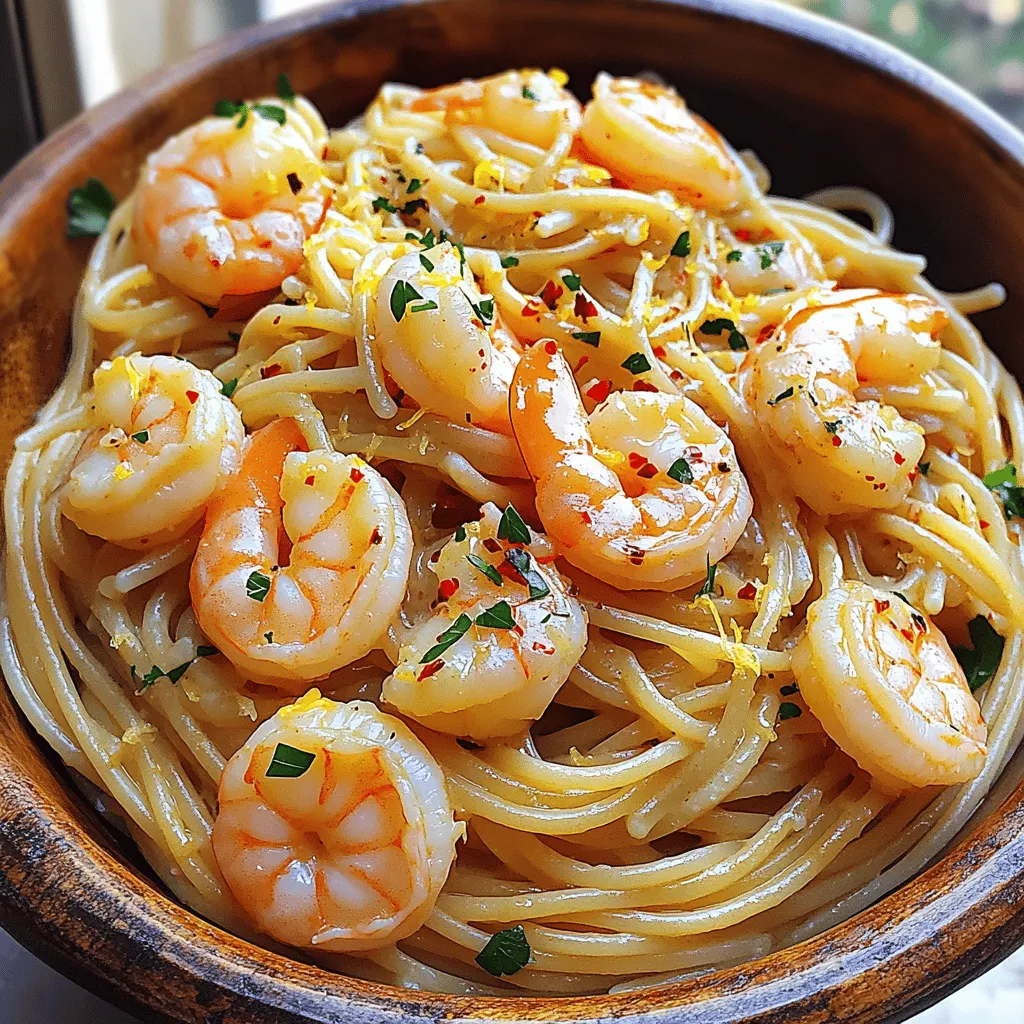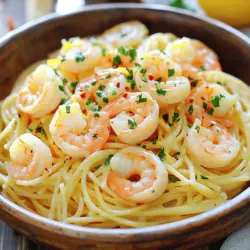Looking for a meal that’s fast, easy, and bursting with flavor? Garlic Butter Shrimp Pasta is your answer! This rich dish combines tender shrimp and spaghetti in a creamy garlic sauce that you’ll want to devour. Whether you’re a cooking novice or a seasoned pro, my step-by-step guide will help you impress anyone at your dinner table. Get ready to dive into a bowl of pure deliciousness!
Ingredients
To make garlic butter shrimp pasta, you need fresh and simple ingredients. Here’s what you will need:
- 8 oz spaghetti or linguine
- 1 lb large shrimp, peeled and deveined
- 4 tablespoons unsalted butter
- 4 cloves garlic, minced
- 1 teaspoon red pepper flakes
- 1 tablespoon lemon juice
- Salt and pepper to taste
- 2 tablespoons fresh parsley, chopped
- Grated Parmesan cheese (optional)
- Zest of 1 lemon (for garnish)
Each ingredient plays a key role in building the dish’s rich flavor. The shrimp brings a sweet taste, while garlic adds depth. Butter gives a creamy texture, and lemon juice brightens everything up. I recommend using fresh parsley for a pop of color and freshness.
If you love cheese, sprinkle some grated Parmesan on top for extra flavor.
Step-by-Step Instructions
Cooking the Pasta
To boil pasta perfectly, start with a large pot of water. Add salt to the water. This helps flavor the pasta. Bring the water to a rolling boil. Then add your spaghetti or linguine. Cook it according to the package instructions until it is al dente. This means it is firm but cooked through. Reserve one cup of pasta water before draining the rest. This water helps create a smooth sauce later.
Sautéing the Shrimp
For the best shrimp, peel and devein them first. Season the shrimp with salt and pepper. Heat a large skillet over medium heat. Melt two tablespoons of butter in the skillet. Add the shrimp in a single layer. Cook for 2 to 3 minutes on each side. They should turn pink and opaque. This is your cue to remove them from the skillet and set aside.
Creating the Garlic Butter Sauce
In the same skillet, melt the remaining butter. Add minced garlic and red pepper flakes. Sauté for one to two minutes. The goal is to infuse the butter with flavor. Be careful not to burn the garlic. If you see it turning brown, lower the heat right away.
Combining Ingredients
Add the cooked pasta and shrimp back into the skillet. Pour in the lemon juice and a splash of reserved pasta water. Toss everything together until well coated. If the sauce seems too thick, add more pasta water. Taste it and adjust seasoning with salt, pepper, or extra red pepper flakes as needed.
Plating and Serving
To plate, serve the pasta in bowls. Garnish with chopped parsley and lemon zest. This adds color and fresh flavor. You can also sprinkle grated Parmesan cheese on top if you like. Enjoy your dish right away for the best taste.
Tips & Tricks
Perfecting the Dish
How to choose the freshest shrimp:
Look for shrimp that is firm and shiny. The shells should be clear or slightly pink. Avoid any shrimp with a strong fishy smell. Fresh shrimp should smell like the ocean, not like ammonia.
Common mistakes to avoid:
One mistake is overcooking the shrimp. It should only take 2-3 minutes on each side. Another common error is not seasoning enough. A little salt and pepper can enhance the flavor a lot.
Cooking Techniques
Importance of using a large skillet:
A large skillet allows shrimp to cook evenly. It also gives room for tossing the pasta and shrimp together. If your skillet is small, the ingredients will steam instead of sauté.
Best methods for preventing pasta from sticking:
To prevent sticking, add salt to the boiling water before cooking the pasta. Stir the pasta often while it cooks. Once drained, toss it with a bit of olive oil to keep it loose.
Flavor Enhancements
Suggestions for additional seasonings:
Try adding fresh herbs like basil or dill. You can also add a touch of white wine for depth. A sprinkle of lemon zest brightens the dish too.
Pairing with complementary side dishes:
Serve garlic butter shrimp pasta with a fresh green salad. A light Caesar salad works well. For a heartier option, garlic bread or roasted vegetables are great choices.

Variations
Alternative Proteins
You can switch shrimp for chicken or tofu. Both options work well with garlic butter. For chicken, use boneless, skinless breasts. Cut them into bite-sized pieces. Cook them until they are golden brown and fully cooked. This takes about 5-7 minutes. For tofu, press it to remove excess water. Then cut it into cubes and sauté until golden. This usually takes about 8-10 minutes. Adjust your cooking times based on the protein you choose. Chicken should reach an internal temperature of 165°F. Tofu should be crisp on the outside.
Gluten-Free Options
If you need a gluten-free option, substitute regular pasta with gluten-free pasta. Rice noodles or chickpea pasta are great choices. Cook them according to package instructions. To keep the flavor strong, add a little extra garlic and seasoning. You might also want to add a splash of lemon juice. This helps balance the dish and keeps it fresh.
Vegetarian Version
To make a vegetarian garlic butter pasta, leave out the shrimp entirely. Instead, use more veggies like spinach or mushrooms. Add them when you sauté the garlic. You can also toss in some cherry tomatoes for a pop of color. They add sweetness and flavor. For the best results, use fresh herbs, like basil or thyme. This will give the pasta a bright, fresh taste. You can still enjoy the rich garlic butter flavor without any meat.
Storage Info
Storing Leftovers
To keep your garlic butter shrimp pasta fresh, follow these tips:
- Refrigerate Quickly: Place leftover pasta in an airtight container. This keeps it safe from bacteria.
- Cool Before Storing: Let the pasta cool to room temperature before sealing. This helps prevent condensation, which can make the pasta soggy.
- Store Shrimp Safely: Keep shrimp in the same airtight container. If you have extra shrimp, it’s best to store them separately. They can spoil faster than pasta.
Reheating Tips
Reheating your garlic butter shrimp pasta properly helps maintain its flavor and texture:
- Use Low Heat: Reheat on the stove over low heat. Add a splash of water or broth to keep it moist.
- Microwave with Care: If using a microwave, cover the dish and heat in short bursts. Stir in between to ensure even heating.
- Avoid Rubbery Shrimp: Shrimp can become rubbery when overcooked. Heat just until the shrimp is warm, around 1-2 minutes.
Freezing Instructions
You can freeze garlic butter shrimp pasta, but here’s how to do it right:
- Yes, You Can Freeze It: Just remember that the shrimp may change texture. It’s best to freeze the pasta without shrimp, if possible.
- Cool First: Allow the pasta to cool completely before freezing. This prevents ice crystals from forming.
- Use Freezer Bags: Store pasta in freezer-safe bags. Squeeze out as much air as you can to prevent freezer burn.
- Thawing Tips: When ready to eat, thaw overnight in the fridge. Reheat gently on the stove or in the microwave.
FAQs
What is the best type of pasta for garlic butter shrimp?
For garlic butter shrimp, I recommend using:
- 8 oz spaghetti or linguine
- Fettuccine can also work, but spaghetti and linguine are best.
Spaghetti and linguine both hold the sauce well. Their thin shape allows the garlic butter to coat every strand. This makes each bite rich and full of flavor.
Can I make garlic butter shrimp pasta ahead of time?
Yes, you can meal prep garlic butter shrimp pasta. Here are some tips:
- Cook the pasta and shrimp separately.
- Store them in airtight containers.
Keep the pasta and shrimp in the fridge for up to three days. To store pre-cooked ingredients, use airtight containers. This keeps them fresh and tasty!
How do I know when shrimp is cooked?
You can tell shrimp is cooked by looking at its color. Cooked shrimp turns pink and opaque. The shrimp should also curl into a “C” shape.
Properly cooking shrimp is important for taste and safety. Undercooked shrimp can be tough and unappetizing.
What can I serve with garlic butter shrimp pasta?
Pair garlic butter shrimp pasta with these sides:
- A fresh salad with lemon vinaigrette
- Garlic bread for a crunchy treat
For wine, I suggest:
- A crisp white wine like Sauvignon Blanc
- A light Pinot Grigio also works well.
These pairings enhance the rich flavors of the dish. Enjoy your meal!
In this article, I shared a simple recipe for garlic butter shrimp pasta. We covered key ingredients and step-by-step instructions to ensure you cook the pasta perfectly. I offered tips on storing leftovers and variations for different diets.
Explore this dish to impress your family or friends. Cooking should be fun, and this pasta dish makes it easy. Enjoy every bite!

